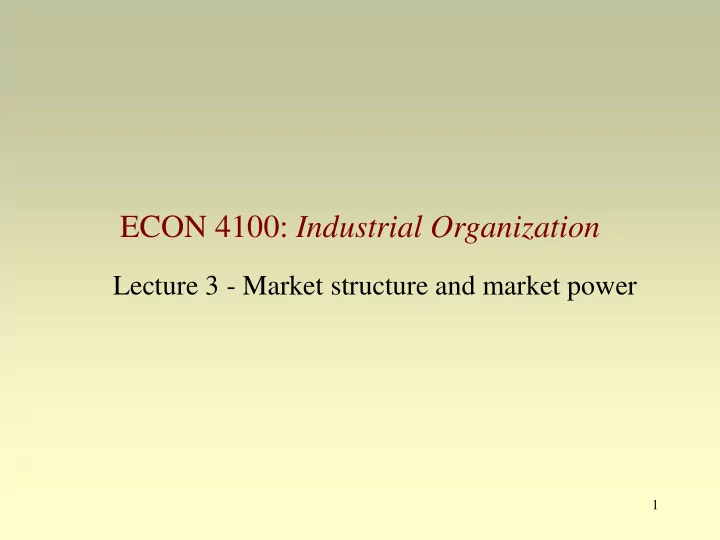

ECON 4100: Industrial Organization Lecture 3 - Market structure and market power 1
Introduction • structure measures • industrial classification systems • vertical and horizontal linkages • non-neoclassical theories of the firm (Coase, Williamson, Hart) 2
Introduction • Industries have very different structures – numbers and size distributions of firms • ready-to-eat breakfast cereals: high concentration • newspapers: low concentration • How best to measure market structure – summary measure – concentration curve is possible (see page 55) – preference is for a single number – concentration ratio or Herfindahl-Hirschman index 3
Introduction – preference is for a single number – concentration ratio – C 4 , C 8 , … or C N (which ignore the rest of the distribution) (CR3 is more common in the UK CR4 in the US) – Herfindahl-Hirschman index (from 0 to 10,000) which reflects a combination of inequality in size and concentration (emphasizing the size of the larger firms by squaring size) 4
Measure of concentration • Compare two different measures of concentration: Firm Rank Market Share Squared Market (%) Share 1 25 25 625 25 2 25 625 25 3 25 625 5 4 5 25 5 5 25 6 5 25 7 5 25 8 5 25 Concentration Index CR 4 = 80 H = 2,000 5
• Concentration index is affected by, e.g. merger Firm Rank Market Share Squared Market (%) Share 1 25 25 625 Assume that firms Market shares 4 and 5 decide 25 2 25 625 change to merge 25 3 25 625 5 4 5 25 } } } 100 10 5 5 25 6 5 25 The Concentration 7 5 Index changes 25 8 5 25 Concentration Index CR 4 = 80 85 H = 2,000 2,050 6
What is a market? • No clear consensus – the market for automobiles • should we include light trucks; pick-ups SUVs? – the market for soft drinks • what are the competitors for Coca Cola and Pepsi? – With whom do McDonalds and Burger King compete? 7
What is a market? • Presumably define a market by closeness in substitutability of the commodities involved – how close is close? – how homogeneous do commodities have to be? • Does wood compete with plastic? Rayon with wool? We can also consider the value of the cross- elasticity of demand between different goods to see to which extent they are substitutes ij q i p j p j q i 8
What is a market? • But we could also consider the value of the cross- elasticity of supply between different goods to see to which extent they are substitutes in supply • Think about left handed and right handed golf clubs!!!!!! On the other hand consider leather gloves versus woolen gloves! ij q i p j p j q i 9
Market definition (cont.) • Definition is important – without consistency concept of a market is meaningless – need indication of competitiveness of a market: affected by definition – public policy: decisions on mergers can turn on market definition • Staples/Office Depot merger rejected on market definition • Coca Cola expansion turned on market definition • Standard approach has some consistency – based upon industrial data – substitutability is production not consumption (ease of data collection) 10
Market definition (cont.) • Government statistical sources – FedStats in USA (StatsCanada here) – Naics (http://www.census.gov/epcd/www/naics.html) • The measure of concentration varies across countries • Use of production-based statistics has limitations: – can put in different industries products that are in the same market 11
Market definition (cont.) • Should we use other measures like capital, number of workers, sales? They all pose problems • The international dimension is important – relevant market for automobiles, oil, hairdressing 12
Market definition (cont.) • Geography is important – barrier to entry if the product is expensive to transport – but customers can move • what is the relevant market for a beach resort or ski-slope? Newspapers: locally defined or nationwide? We should not forget that simplistic domestic measures of concentration ignore IMPORTS If the market is open (like Canada) we need to adjust our conclusions after looking at measures of concentration 13
Market definition (cont.) • Vertical relations between firms are important – most firms make intermediate rather than final goods – firm has to make a series of make-or-buy choices – upstream and downstream production – measures of concentration may assign firms at different stages to the same industry • do vertical relations affect underlying structure? 14
Market definition (cont.) – Firms at different stages may also be assigned to different industries • bottlers of soft drinks: low concentration • suppliers of soft drinks: high concentration • the bottling sector is probably not competitive. Also, perhaps concentration helps competition (a merger allows a couple of smaller firms to pose competition to the big guys in the market) • In sum: market definition poses real problems – existing methods represent a reasonable compromise 15
Market power – A measure of market power is the Lerner Index: LI =(P-MC)/P Which equals LI = 1/price-elasticity It goes from 0 to 1 But it may be a misleading measure of market power too (when there are high sunk costs you can have many firms only if you leave a good gap between P and MC to cover the sunk costs!) 16
Next – Technology and Cost 17
Recommend
More recommend